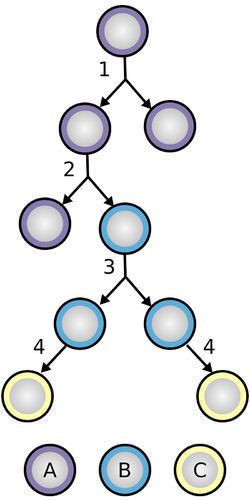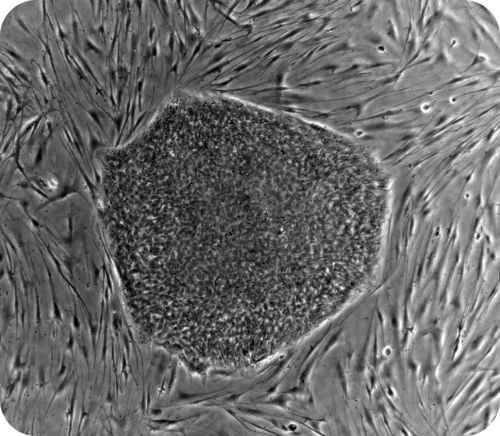1.1 人体细胞
章节大纲
-
How is the similar to a well-tuned machine?
::如何相似于一个运转良好的机器?Over and over, the human body is compared to a complex piece of machinery. Like any common machine, the human body is composed of a variety of parts, each working separately, but also working together.
::人的身体被比作复杂的机器。 和任何普通机器一样,人的身体由不同的部分组成,每个部分分开工作,但也一起工作。Cells
::单元格单元格are the most basic units of life in your body, and each cell is specialized, with a specific function. Nerve cells transmit electrical messages around the body, and white blood cells attack invading throughout the body. Other cells include specialized cells in the (such as kidney glomerulus parietal cells), brain (such as astrocytes), stomach (such as parietal cells), and (such as red and white fibers). Cells group together to form tissues ; different tissues work together to form organs . This grouping of cells and tissues is referred to as levels of organization. Complex , which include and humans, have different levels of organization. The human body's levels begin with cells and conclude with the entire organism . Flatworms, though they lack specialized circulatory and respiratory systems, also have levels of organization ranging from cells to the entire organism.
::神经细胞在身体周围传递电文,白色血细胞在整个身体中受到攻击。其他细胞包括特殊细胞(如肾脏球状细胞)、大脑(如天体细胞)、胃(如皮肤细胞)和(如红纤维和白纤维),细胞组组成组织;不同的组织组共同组成器官。这种细胞和组织组称为组织层次。复杂细胞和人类,组织层次不同。人体的层次从细胞开始,与整个有机体结束。虫虽然缺乏专门的循环和呼吸系统,但组织层次也从细胞到整个有机体不等。Different types of cells in the human body are specialized for specific jobs. Do you know the functions of any of the cell types shown here?
::人体中不同种类的细胞专门用于特定任务。 您知道这里所显示的任何细胞类型的功能吗 ?Differentiation
::差异化Every cell in the body originates from a single fertilized egg called a zygote . The zygote divides repeatedly to produce an embryo . These embryonic cells continue to divide, differentiating into all the cell types present in the body of all humans (and other mammals), from a new-born baby to an elderly adult. Differentiation is the process by which an unspecialized cell, such as a fertilized egg cell, divides many times to produce specialized cells. During differentiation, certain genes are turned on, or become activated, while other genes are switched off, becoming inactivated. This process is regulated by the cell. A differentiated cell will develop specific structures and perform certain functions.
::身体中的每个细胞都来自一个叫做zygote的受精卵。 zygote 的分裂会反复产生胚胎。 这些胚胎细胞继续分裂, 分为所有人体( 和其他哺乳动物) 体内的所有细胞类型, 从新生婴儿到老年人。 区别是一个非专门细胞, 如受精卵细胞, 分裂了很多次来产生专门细胞的过程。 在区别期间, 某些基因被打开, 或被激活, 而其他基因则被关闭, 被激活。 这个过程由细胞来调节。 不同的细胞将开发特定的结构, 并发挥某些功能 。A cell that is able to differentiate into all cell types within a body is called totipotent. They have “total potential” to differentiate into any cell type. In mammals , only the zygote and early embryonic cells are totipotent. A cell that is able to differentiate into many, but not all, cell types is called pluripotent. Such cells have “plural potential” (but not “total potential”) to differentiate into most cell types. Figure gives a visual representation of cell differentiation.
::在哺乳动物中,只有zygote和早期胚胎细胞是全能的。能够区分身体内所有细胞类型的细胞被称为“全能”细胞。它们“完全潜力”可以区分任何细胞类型。在哺乳动物中,只有zygote和早期胚胎细胞是全能细胞。能够区分许多但并非全部细胞类型的细胞被称为多能细胞。这些细胞具有“多元潜力”(但并非“总潜力 ” ) 可以区分大多数细胞类型。图提供了细胞差异的直观表现。Division and differentiation of stem cells into specialized cells.
::将干细胞划分和区分为专门细胞。Stem Cells
::Stem 单元格An unspecialized cell that can divide and give rise to different specialized cells is called a cell ( Figure ). Zygotes and embryonic cells are both types of stem cells. These stem cells, called embryonic stem cells, can divide indefinitely and can specialize into any cell type. They are totipotent. In contrast, adult stem cells, also known as somatic stem cells, are undifferentiated cells found within the body that divide to replace dying cells and damaged tissues. Adult stem cells can divide indefinitely and generate all the cell types of the organ from which they originate. They can potentially re-grow the entire organ from just a few cells. A third type of stem cell is found in both the from the umbilical cord of a new-born baby and the placenta . These "cord blood stem cells" are considered to be adult stem cells because they cannot generate all body cell types, just different types of blood cells. Adult stem cells and cord blood stem cells are pluripotent.
::能够分裂和产生不同专门细胞的未专门细胞称为细胞(图)。Zygotes和胚胎细胞是两种干细胞。这些干细胞,称为胚胎干细胞,可以无限期地分裂,可以专门形成任何细胞类型。它们是多功能的。相比之下,成年干细胞,又称为体形干细胞,在身体内发现无差别的细胞,可以分离替代垂死细胞和受损组织。成年干细胞可以无限期地分裂,产生所有器官的细胞类型。它们可能只是从少数细胞中重新生长整个器官。第三种干细胞来自新生婴儿和胎盘的脉系。这些“血干细胞”被认为是成人干细胞,因为它们不能产生所有身体细胞类型,只是不同类型的血细胞。成年干细胞和绳状血干细胞是多功能的。Stem Cells in Medicine
::药物中的毒细胞Stem cells are of great interest to researchers because of their ability to both divide indefinitely and differentiate into many cell types. Stem cells have many existing and even more potential therapeutic applications. Such therapies include treatments for , blood disorders, brain or spinal cord injuries, and blindness.
::恒定细胞对于研究人员来说非常重要,因为它们既能够无限期地分裂,又能够分为许多细胞类型。 恒定细胞有许多现有的甚至更潜在的治疗用途。 这种疗法包括治疗血病、脑或脊髓损伤以及失明。A human embryonic stem cell colony, which was grown in a laboratory on a feeder layer of mouse cells.
::人类胚胎干细胞聚居区,在老鼠细胞支线层的实验室中生长。Embryonic stem cells, shown in Figure , are taken from eggs that were donated to research and fertilized in the . These stem cells may have the greatest potential because they are totipotent and thus have the most potential medical applications. However, embryonic stem cells are relatively controversial. Some individuals and groups have objections to the harvesting of embryonic stem cells because harvesting the stem cells involves the destruction of the embryo. Some researchers are looking into methods of extracting embryonic stem cells without destroying the actual embryo. Other researchers have claimed success in harvesting embryonic stem cells from the embryonic fluid that surrounds a growing fetus . Additionally, stem cells harvested from a donated embryo differ from a potential patient’s tissue type. Therefore, just as in organ transplantation, there is a risk that the patient’s body may reject the transplanted embryonic stem cells.
::图中显示的胚胎干细胞取自用于研究和施肥的卵子。这些干细胞可能具有最大的潜力,因为它们是无能的,因此具有最大的医疗应用潜力。然而,胚胎干细胞相对具有争议性。一些个人和团体反对收获胚胎干细胞,因为摘取干细胞会破坏胚胎。一些研究人员正在研究提取胚胎干细胞的方法,而不会破坏实际胚胎。其他研究人员声称在收获胚胎细胞中胚胎干细胞方面取得了成功,因为胚胎中产的胚胎流动会包围着一个不断成长的胎儿。 此外,从被捐赠的胚胎中提取的细胞与潜在的病人的组织类型不同。 因此,正如器官移植一样,病人的身体可能拒绝移植胚胎干细胞。Adult stem cells, including cord blood stem cells, have already been used to treat diseases of the blood such as sickle-cell anemia and certain types of cancer. Unlike embryonic stem cells, the use of adult stem cells in research and therapy is not controversial because the production of adult stem cells does not require the destruction of an embryo. Adult stem cells can be isolated from tissue samples, such as bone marrow , of a patient. Scientists have recently discovered more sources of adult stem cells in the body including in body fat, the inside lining of the nose, and the brain. Some researchers are investigating ways to revert adult stem cells back to a totipotent stage.
::成人干细胞,包括骨髓血干细胞,已经被用来治疗血液疾病,如镰状细胞贫血和某些类型的癌症,与胚胎干细胞不同,在研究和治疗中使用成人干细胞没有争议,因为生产成人干细胞不需要破坏胚胎。成人干细胞可以与病人的组织样本(如骨髓)隔离。科学家最近发现身体中成人干细胞的来源更多,包括身体脂肪、鼻内衬和大脑。一些研究人员正在研究如何将成人干细胞恢复到最有能力的阶段。Summary
::摘要-
Cells are the most basic units of life found in the human body and any living organism.
::细胞是人体和任何生物体中发现的最基本生命单位。 -
Stem cells undergo the process of differentiation to become specialized cells.
::Stem细胞经受了差别化过程,成为专门的细胞。
Review
::回顾-
What are totipotent and pluripotent cells?
::什么是能及能及多功能的细胞? -
What are stem cells? Where do they come from?
::干细胞是什么?
Explore More
::探索更多Use the video above to answer the following questions:
::使用以上视频回答下列问题:-
When did scientists first understand the idea of differentiation?
::科学家什么时候才开始明白区别的概念? -
What changes in a totipotent cell to make it specialize?
::使一个能力极强的细胞专门化的改变是什么? -
Can a blood stem cell become a muscle, brain, and/or liver cell?
::血干细胞能否变成肌肉、大脑和/或肝细胞?
-
Cells are the most basic units of life found in the human body and any living organism.


